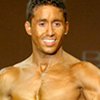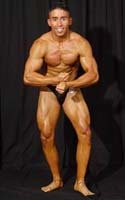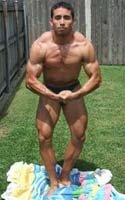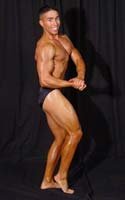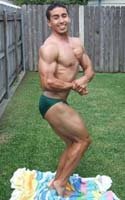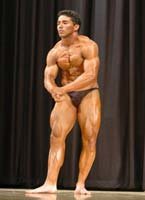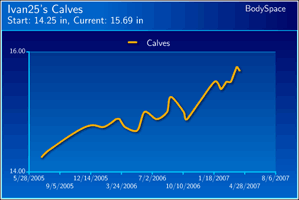As we all know, calves are one of the most stubborn muscle groups to develop. Rather than bore one with a rudimentary explanation of basic anatomy and kinesiology, I will make this article very practical.
This program, however, is for those who have tried just about everything to get their calves to grow to no avail. The key to getting calves to grow in natural bodybuilders is through precision training, hard work, dedication, and the enthusiasm to continue to learn and be open to new ideas. I have to alert readers beforehand that this approach to calf-training is completely out of the ordinary.
Hypertrophy Of Calf Musculature
First, to understand how to get calves to grow, one needs to know what stimulates the calf musculature to grow (hypertrophy) and take on a better shape. After all, isn't this what bodybuilding is all about, hypertrophying all major muscle groups to allow each muscle to reach it's peak anatomical shape?
If I were to take an educated guess as to what the human body's muscles on an anatomy chart were taken after, I would guess a world-class bodybuilder. I mean, if we were autopsied, we would have the best representation of muscular development amongst all men.
The muscles of an everyday man would not look like the big and clearly delineated ones we see in an anatomy chart. Anyhow, back the topic at hand. Essentially, we need to hypertrophy the entire calf musculature. This calf musculature is commonly referred to as the "triceps surae" (Signorile et al. 2002).
The triceps surae is composed of three muscles (gastrocnemius, soleus, and plantaris), but only the gastroc and soleus are relevant in this discussion. This is a critical fact since it will later become an important practical application.
Muscle Fibers
From a muscle physiology perspective, the gastrocnemius is made up of approximately 51% fast-twitch muscle (Green et al., 1981), while the soleus is made up of approximately 80% slow-twitch muscle (Gollnick et al., 1974).
Thus if the bulk of these fibers make-up these respective muscle groups, one should train the gastroc's in the 6-12 rep range, while the soleus is trained in the 15-30 rep range. Not so fast!!!
We have to understand that the muscle fibers with the greatest potential for growth and size are the fast-twitch fibers. So in essence, we should hypertrophy these fast twitch fibers first, then hypertrophy the muscle's dominant fiber type. So for the gastroc AND soleus, one should train them in the rep range of 1-6 reps for size and 10-100 reps for size (I will this explain later).
Performing 1 rep sets (2-3 RM) using the rest-pause method stimulates growth. One should work mainly in the 2-6 rep range for high-intensity loads. This increases the submax weights one uses, thus more reps at lighter weights. This follows the train of thought that "Bigger muscle is stronger muscle."
For calves, we need to make them go way beyond what they are used to (overload). Using variety is also very critical (shock principle). Additionally, one should have a calf only day. This could be on a recovery or normal rest day during your split so that the rest of your body recovers, while your calf day will not significantly effect total body recovery.
I workout calves only once a week because if you are a natural bodybuilder like me, and you train your calves as hard as you can, you will only need to train them once per week in order to allow maximal stimulation and maximal recovery and growth (Linossier et al. 1997).
This is why some people find exercise more difficult "metabolically" after a long-layoff, yet come back stronger. The fast-twitch fibers take longer to recover than the slow-twitch fibers (Linossier et al., 1997). This mentality follows the philosophy of Mike Mentzer; however, my approach is slightly different, since I perform more than 1 set.
My Training
My training split often changes, but this is an example of how I would incorporate a calves-only day during my off-season split (Off-season is the time I truly do my weak-point training in preparation for an upcoming contest):
- Mon: Legs
- Tues: Chest and Upperback
- Weds: Calves
- Thurs: Shoulders and Traps
- Fri: Biceps and Triceps
In the past 2 years, my calves have made remarkable growth!! They have grown from 14 1/2 inches to about 16 inches (See above progress pics & Graph below)!! This is important for those who struggle with calves since I was born with pretty thin and small calves myself.
However, my calves are long, which means that their peaks are small now, but over time (maybe 3-4 more years) they will be like Arnold's, relative to my frame and size of course. The longer the calf belly, the more potential for growth. As you can see in the graph (see below), my calf growth follows a very normally achieved pattern.
We all should know that progress is usually non-linear throughout and occurs in a zig-zag manner. The reasoning for these peaks and valleys is due to the nature of the human organism. If you follow my graph, the line is not a like a steady linear increase, but rather a nonlinear increase. What is important is the fact that my calves are headed in the right direction.
The reason for the non-linear nature is due to the following:
- Reaching a plateau throughout a training cycle
- Body fat reduction for various contests, and finally
- Having significant strength breakthroughs using periodization.
Essentially, I am starting each off-season and pre-contest cycle with bigger and stronger calves. This is how muscles are supposed to grow. The initial gains are rapid, but as we all know, they slow down drastically as we become advanced. This is where we need to shock our muscles into new exercises, intensities, and training methods to stimulate further growth.
So for my last off-season my calves peaked out at 15 1/2 inches, for this off-season they peaked out at 16 inches. During my last pre-contest phase, they peaked out at 14 3/4 inches, during my most recent pre-contest phase they peaked out at 15 1/4 inches.
The point is I am re-setting the starting point of my calf size for each phase. With body fat being reduced to a mere 5-6% pre-contest, my calf size is increasing, thus everything else is controlled for allowing one to see that my increases are from pure muscle gain.
Yes, muscle gains can occur this slowly!!! My calves are still growing and I expect them to get to possibly 17-18 inches, maybe more. I will never know until I hit a plateau that does not allow any more growth; my genetic ceiling.
These are the calf workouts I do currently:
Calf Workout 1
Goal here is to hypertrophy gastroc's
1. Mass Builder
- Leg press machine calf raise: 3-4 warm-up sets increasing weight each warm-up set.
- Regimen 1: 20x1 (rest-pause) 1,100 lb is what I use, which is roughly my 2-3 RM. I would suggest you use your own 2-3 RM for weight. What I do is unrack the weight, perform one solid rep, then re-rack and rest for 10-15 seconds before going again.
- Regimen 2: 5x3
- Regimen 3: 10x10
- Regimen 4: 2x100 (modified rest-pause) Do 100 in as few sets as possible. Rest like 15-20-seconds between mini-sets within the 100 rep set. Use your 6-8 RM.
*For weight, I do not include the weight of the sled. I just refer to the weight loaded on the machine.
To shock your calf unit, be sure to incorporate partials from both ranges. From full stretch bottom position just half-way up; this emphasizes lower calf (Antonio, 2000; Schwarzenegger, 1998). And from half-way point to toes being completely pointed like a ballerina; this emphasizes upper calf (Antonio, 2000; Schwarzenegger, 1998). Include these variations to keep workouts different. And to keep your calves on their toes literally!!!
2. Symmetry Achiever
- Standing single-leg calf raises: with your toe on a block: 3x5-8 + forced peak contraction reps.
Use your 5-8 RM and when your calf gets fatigued, take your other leg and place the toe under the heel of your working leg. Come down on your toe and use the foot of your non-working leg to assist your working calf to do some forced peak contraction reps and some additional forced-forced peak contraction reps!!
What you will be doing is peak contraction by forcing your fatigued calf to point like a ballerina. Also, the best place to do this exercise is leaning on the dumbbell rack with your free hand and holding a heavy dumbbell in the other hand.
Calf Workout 2
Goal here is to hypertrophy soleus
1. Mass Builder
- Seated calf raise: 2-3x2-3
I start this workout with seated calf raise. I do 4-5 warm-up sets 20-15-12-8-6 (45lb-90lb-135lb-180lb-225lb)* I do 2-3 working sets x 2-3 reps with 225lb. and/or 250-270lb. Depending on how I feel, I either do 2-3 straight sets with 225 lb. or I will pyramid the weight each set up to 270 on my last heavy set.
Then after this I perform 1 severe drop set stripping each 45 lb. plate off the peg for 5-6 grueling burn-out sets (270lb-225lb-180lb-135lb-90lb-45lb). The burn out sets take care of the predominant slow-twitch fibers of the soleus. Be sure to get full-stretch at bottom position!!
2. Best Calf Exercise
I improvise on this one since my gym doesn't have a donkey calf raise machine. Instead, I use the smith machine. I place a support pad on the bar. Then I place a block under my toes. I put the safety stops on a level where my lower back is slightly lower than my shoulders. I rest my arms on a bench that is high enough to allow this optimal position of my lower back being in neutral. I then load up to three or four 45's on each side.
I don't load much more, because I do not trust the smith machine's capacity. However, I get a great burn and feeling of growth from these. Why? Simple, the donkey calf raise the single most effective calf exercise for the following reasons:
- It reduces the distance of the load to the calves.
- It takes the weakest link out of the equation (the lower back).
- It places the calves in their deepest possible stretch from start to finish. Reason being, the calf inserts on the thigh bone, and it performs two motions: points the toes and flexes the knee (Hamilton & Luttgens, 2002).
When one bends over at the waist this puts great stretch on the calf across both the knee and ankle joints. Thus it is maximally stretched for maximal stimulation!!
Going Heavy On The Soleus
Logic to going heavy for soleus is simple. Shock principle, priority hypertrophy of fast twitch fibers, and stronger muscle is bigger muscle. I have made significant gains going heavy on seated calves.
Remember that the soleus is like the brachialis muscle of the upperarm, the soleus is under the gastroc so it will improve size two-fold.
- It will push the gastroc out more and
- It will add more width to the calf (Schwarzenegger, 1998).
Furthermore, one should know that the point of origin for the gastroc and soleus are slightly different. However, the most common site of soreness for the calves is usually behind the knee. When I did heavy seated calves, that point of origin was sore!!!
Although both points are different, I felt soreness when doing a straight-legged calf stretch. It felt like I had worked my gastroc's, but in actuality I worked my soleus. How could this be? Well, recall that the triceps surae is the common point where both muscles adjoin. They both adjoin at the achilles heel, but not behind the knee.
Essentially what I believe happened is I made my soleus sore for the first time ever!!! And I did it going HEAVY on seated calves. Not going for high reps like most experts recommend.
 Check Out Ivan Blazquez's BodySpace Here!
Check Out Ivan Blazquez's BodySpace Here!
References:
- Antonio, J. (2000). Nonuniform response of skeletal muscle to heavy resistance training: Can bodybuilders induce regional muscle hypertropy? Journal of Strength and Conditioning Research, 14 (1), 102-113).
- Gollnick, P.D. et al. (1974). Human soleus muscle: A comparison of fiber composition and enzyme activities with other leg muscles. Pflugers Arch, 348, 247-255.
- Green, H.J. et al. (1981). Human vastus lateralis and gastrocnemius muscles. A comparative histochemical analysis. J. Neurol. Sci., 52, 200-210.
- Hamilton, N. & Luttgens, K. (2002). Kinesiology: Scientific basis of human motion. McGraw-Hill Inc., New York, NY.
- Hansen, J. (2005). Natural Bodybuilding. Human Kinetics, Champaign, IL.
- Linnossier, M.T. et al. (1997). Enzyme adaptations of human skeletal muscle during bicycle short-sprint training and detraining. Acta Physiol Scand, 161(4), 439-445.
- Signorile, J.E. et al. (2002). Selective recruitment of the triceps surae muscles with changes in knee angle. Journal of Strength and Conditioning Research, 16(3), 433-439.
- Schwarzenegger, A. (1998). The new encyclopedia of modern bodybuilding. Simon & Schuster, New York, NY.
The information provided in this article is for educational and informational purposes only and does not serve as a replacement to care provided by your own personal health care team or physician. The author does not render or provide medical advice, and no individual should make any medical decisions or change their health behavior based on information provided here. Reliance on any information provided by the author is solely at your own risk. The author accepts no responsibility for materials contained in the article and will not be liable for any direct, indirect, consequential, special, exemplary, or other damages arising from the use of information contained in this or other publications.
Copyright © Ivan Blazquez, 2007. No part of this publication may be reproduced or transmitted in any form without the prior written permission of the copyright holder and author of this publication.
